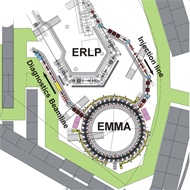At Daresbury Laboratory in England, a team of scientists recently completed the first successful runs on a new prototype that may change the way accelerators speed up particles. Its novel design, scientists said, is capable of energies beyond the reach of current cyclotrons, with acceleration rates exceeding those of the most powerful synchrotrons – all within a compact, cost-effective and operationally simple package.
Daresbury’s accelerator, called EMMA, gains its technological edge through a high-intensity accelerator concept nearly abandoned a half century ago.
The accelerator’s magnet configuration incorporates a fixed field, rather than a pulsed field like a cyclotron, but includes alternating gradients like a synchrotron. The first versions of these fixed-field alternating-gradient machines were invented independently in Japan, Russia and the U.S. in the early 1950s.
The U.S. FFAG came about through the Midwest Universities Research Association, a group of 15 universities dedicated to developing a machine capable of accelerating particles beyond a billion electron volts, or 1 GeV. This unique institution soon built the first FFAG prototypes, albeit low-energy models.
“It was an exceedingly clever group of people. They had lots of ideas,” said Alvin Tollestrup, a long-time Fermilab physicist who attended MURA’s FFAG workshop.
For nearly 10 years, the MURA team pushed for a high-energy, high-intensity FFAG accelerator. One of several designs the group developed included colliding beams that essentially doubled the collision energy. They submitted a number of their proposals for machines in the 10-20 GeV range to the Atomic Energy Commission. None were approved.
Meanwhile, the invention of the storage ring and cascaded synchrotrons significantly reduced the cost of high-energy accelerators. As a consequence, a 1963 report, chaired by Norman Ramsey, to the Atomic Energy Commission ranked the FFAG project lower in priority than the competing proposals for high-energy particle beams.
Under rising excitement over a new strong-focusing synchrotron design that could achieve 300 GeV, and in the heat of an increasingly contentious political climate, the new president, Lyndon B. Johnson, rejected the MURA proposal on the basis of the report. MURA then disbanded, with the scientists shifting to accelerator laboratories like Fermilab, Berkeley and Brookhaven.
Although the technological advances and heavy influence of the MURA team did in part lead to the construction of Fermilab in the Midwest, the FFAG fell into obscurity.
Decades later, in a 1997 UCLA workshop on muon colliders, Fermilab physicist Carol Johnstone, while collaborating with one of the original MURA physicists, Fred Mills, proposed a new type of FFAG, termed non-scaling.
The FFAGs of the ‘50s followed a strict scaling method for the magnetic field to confine and accelerate beam. In the quest for a rapid acceleration scheme for unstable particles began a project that would for the first time ever combine FFAG with a new non-scaling method of beam confinement that resulted in smaller, simpler magnets.
The U.K.’s drive for an affordable collider that would accelerate and collide heavy elementary particles called muons set the stage for the prototype to be built at Daresbury Laboratory by a volunteer team of international scientists. Applied to a muon collider, the new non-scaling FFAG design would rapidly accelerate and inject the short-lived muon particles into storage or a collision before they decayed away.
“Emma was a bandwagon effect. It attracted accelerator physicists from across the world,” Johnstone said. “It’s the new technology that attracts the best.”
This FFAG format has the potential to quickly reach energies higher than 1 GeV, though the EMMA electron prototype tested at a moderate 20 million electron volts. The success of the preliminary runs put to rest decades of skepticism over FFAG technology. At a time when laboratories are pushing for more high-intensity experiments, the new approach is piquing interest among investors.
“Now that EMMA works, it’s considered a breakthrough,” Johnstone said. “And it’s a proof of principle for industry, too.”
Eventually EMMA’s method could be applied to a broad spectrum of accelerators. In medicine, the lower cost, versatile design and higher performance would enhance and expand proton and ion cancer therapy. For nuclear power, this accelerator-based approach could generate energy more safely while reusing old waste stockpiles. Along with muon colliders, a more cost-efficient generation of accelerators would greatly enhance experiments requiring high-energy neutrino beams.
“It’s interesting, I think, that something that was cooked up and kicked around 50 years ago all of a sudden could become quite interesting,” said Alvin Tollestrup. “There’s a number of interesting ideas for accelerators that haven’t been explored yet that could really change the way we accelerate particles.”
The journal Nature Physics recently covered the science behind EMMA in detail. For more history on FFAG, MURA and Fermilab, read “Fermilab: Physics, the Frontier, and Megascience,” by Lillian Hoddeson, Adrienne Kolb and Catherine Westfall.








